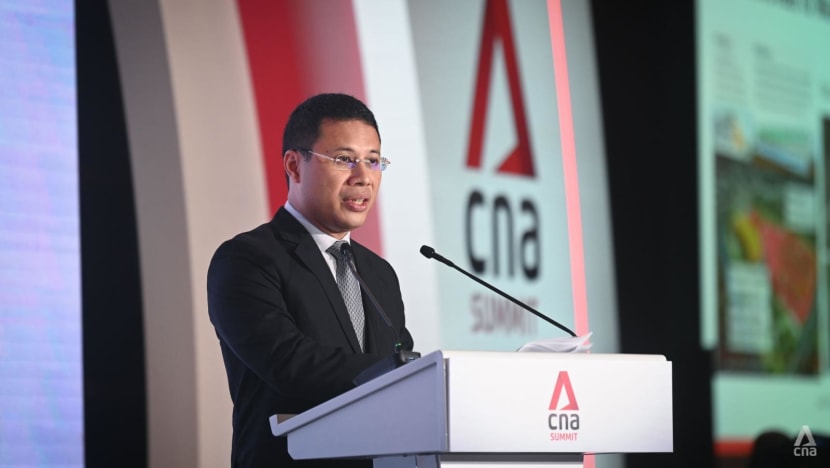Long-term Singapore projects like 'Long Island' require political will: Desmond Lee
Singapore must be prepared to embark on projects that take decades to bear fruit, said the Minister for National Development at the CNA Summit.

Minister for National Development and Minister-in-Charge of Social Services Integration Desmond Lee, delivering the opening keynote address at the CNA Summit 2025 on Feb 20, 2025. (Photo: CNA/Syamil Sapari)

This audio is generated by an AI tool.
SINGAPORE: Singapore must be prepared to embark on projects that take decades to bear fruit, and have the political will and the resources to follow through, said Minister for National Development Desmond Lee on Thursday (Feb 20).
Speaking at the CNA Summit at Pan Pacific Singapore, he said such projects are not easy, and they take time, effort and resources to overcome complex technical challenges.
"Yet we pursue them because the long-term benefits are clear. They transform constraints such as land scarcity into catalysts for forward-thinking urban solutions and sustainable growth," said Mr Lee.
For example, "Long Island" – Singapore's "ambitious" plan to develop its southeastern coast – will protect the low-lying area against rising sea levels.
The plan will also make space for future needs such as housing, recreation and jobs, as well as a new reservoir to enhance Singapore's water security, said Mr Lee.
"It will take many decades to complete; we've just started. But we have to start coastal protection work now, because the price of delay or failure will be too high for future generations to bear," he added.
Having the political will and resources to follow through on projects is one of the four key approaches driving Singapore's strategies to overcome its constraints, Mr Lee noted.
Disciplined long-term planning has been institutionalised in Singapore's land-use planning since the 1950s, he added.
Every 10 years, the government conducts a long-term plan review to plan 50 years into the future, and then translates this into a detailed masterplan for every part of Singapore for the next 10 to 15 years, said the National Development Minister.
Singapore also brings agencies and stakeholders together to execute and implement plans effectively – preparing the land, putting in infrastructure and addressing pain points as the projects roll out, he added.
Even while the government plans for the long term, it should stay nimble and agile, refreshing its plans to keep pace with new developments, said Mr Lee.
"This was particularly important during black swan events like the COVID-19 pandemic. We had to find land and adapt spaces for additional medical facilities, for dorms and other urgent users," he added.
Three factors also enable Singapore to turn its vision into reality, said the minister.
Pushing boundaries in using technology, artificial intelligence and digital tools contributes to more efficient planning, designing and building, said Mr Lee.
The government must also engage the public and its stakeholders extensively, he added, noting that it conducts briefings, dialogues, town halls and more to develop plans with the public.
"We do this for many of our major plans," said Mr Lee, adding that Alliances for Action - industry-led coalitions working with the government - also enable the government to partner Singaporeans to address a common challenge.
"Each member contributes their perspective and resources, and together ... we achieve more than the sum of our individual efforts," said the minister.
Singapore's success has been anchored by its strong social compact, which "embodies a mutual understanding", said Mr Lee.
"For generations, Singaporeans have looked beyond our own personal interests and made sacrifices," he added.
"Aspirations can outstrip the reality of our size and our resources, yet a truly successful society is one where everyone succeeds together."
For this to happen, Singapore must continue to foster a strong sense of collective responsibility and to constantly think of the next generation, said Mr Lee.
MANAGING TRADE-OFFS
At the summit, Mediacorp CEO Tham Loke Kheng also spoke about navigating trade-offs and how leaders manage competing priorities.
The current landscape is defined by volatility, uncertainty, complexity and ambiguity, which creates a leadership environment where trade-offs are unavoidable, she said.
The list of trade-offs is endless, and so are the skills that leaders need to deal with them, said Ms Tham.
This includes adaptive thinking, making decisions amid ambiguity, emotional intelligence and communicating strategically but authentically, she added.
"Sometimes being able to master all these at the same time really feels like a herculean challenge, at least to me," she said.
This year's CNA Summit zeroed in on "Trade-offs in Leadership", exploring how today’s CEOs juggle the critical factors that determine whether an organisation thrives or falters.
Top industry voices spoke during the two panel discussions at the summit on Thursday.
Citi Singapore's country officer and banking head Tibor Pandi, Singlife Group CEO Pearlyn Phau and CEO of the Singapore Business Federation Kok Ping Soon discussed identifying and developing talent in organisations.
The second panel comprised DBS Group CEO Piyush Gupta, OPPO’s president for APAC Andy Shi, ST Telemedia president & Group CEO Stephen Miller and CEO of the National Volunteer and Philanthropy Centre Tony Soh. They discussed the role of leadership in balancing trade-offs and the importance of managing stakeholder expectations.















